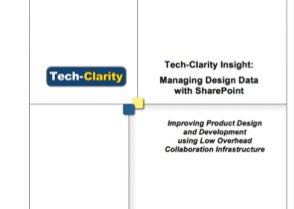 Tech-Clarity Insight – Managing Design Data with SharePoint – Improving Product Design and Development using Low Overhead Collaboration Infrastructure explains how general document management and collaboration infrastructure can be extended to manage product designs. The report reviews the business benefits of controlling, accessing, and sharing design data and the challenges manufacturers face in unmanaged environments. It then shares the experiences of four small to midsize manufacturers, Eurotech Benelux, FPEE, Teledyne, and Theebo Tech, in various levels of maturity using SharePoint for design data.
Tech-Clarity Insight – Managing Design Data with SharePoint – Improving Product Design and Development using Low Overhead Collaboration Infrastructure explains how general document management and collaboration infrastructure can be extended to manage product designs. The report reviews the business benefits of controlling, accessing, and sharing design data and the challenges manufacturers face in unmanaged environments. It then shares the experiences of four small to midsize manufacturers, Eurotech Benelux, FPEE, Teledyne, and Theebo Tech, in various levels of maturity using SharePoint for design data.
The report concludes that manufacturers can get significant value from SharePoint-based solutions, but that SharePoint requires some important extensions in order to be effective. With these modifications, however, companies can take advantage of relatively low-cost infrastructure software from Microsoft that requires few IT resources to manage.
Please enjoy the summary below, or click the report to download a PDF overview (free of charge, no registration required).
For the full report, please visit Siemens PLM’s Solid Edge SP page (free of charge, registration required).
 With special thanks to Siemens PLM, you can also download the full Managing Design Data with SharePoint paper in French (Gérer les donné de conception avec SharePoint) or download a French summary of Managing Design Data with SharePoint (free of charge, no registration required).
With special thanks to Siemens PLM, you can also download the full Managing Design Data with SharePoint paper in French (Gérer les donné de conception avec SharePoint) or download a French summary of Managing Design Data with SharePoint (free of charge, no registration required).
Table of Contents
- The Business Value of Effective Design Data Management
- Control, Access, and Share Design Data
- Avoid the Pitfalls of Unmanaged Data
- Leverage Existing Infrastructure to Centralize and Collaborate
- Pros of Managing Designs and Projects with SharePoint
- Cons of Managing Designs and Projects with SharePoint
- Explore SharePoint-based Design Management Solutions
- Conclusion
- Recommendations
- About the Author
Executive Overview
Tech-Clarity research shows that effectively managing design data offers tangible business value. It helps manufacturers grow their business, respond rapidly to market changes, and control cost to improve profitability. Data management does this by helping companies better control, access, and share their designs and related product information. Unfortunately, data management solutions have been out of reach for some companies due to cost and lack of IT resources, forcing them to rely on less effective approaches like storing data on shared drives and folders. These unmanaged approaches are risky and lead to inefficiency and errors, often relying on designers to follow confusing naming standards and file storage processes.
One alternative to an unmanaged environment is to use a collaboration and document management platform such as Microsoft SharePoint to manage designs. This helps organize files and make information easier for designers to access. SharePoint is an attractive collaboration platform for manufacturers because it has a very low total cost of ownership (TCO), leverages existing investments, and requires very little user training.
Although SharePoint offers some level of control and collaboration, it does not natively support the complexity of product development and engineering data. But SharePoint is more than a tool. It is designed as a development platform that can be extended for special needs like engineering. Software vendors with expertise in product development and engineering have taken advantage of this, extending SharePoint to handle the unique needs of managing CAD files and their complex relationships.
SharePoint-based design management solutions allow engineers to simplify data management so they can focus on designing products. They help designers view and make sense of the relationships between CAD files, specifications, BOMs, and other product-related information. “With our SharePoint-based design management system we clearly see the links and inter-relationships between all of our designs and parts, we have more clarity, and it’s easier to see where things are used and the effect of design changes,” says Theodore Turner of Theebo Tech, “We can see the whole ball of twine.”
Although they may not offer all of the advanced capabilities and scalability found in purpose-built PDM/PLM systems, SharePoint-based solutions can offer the best of both worlds by combining the business value of better design data management with lower cost and less demand for IT resources.

